Is The Giant’s Causeway Worth Visiting? + Money Saving Tips!
The Giant’s Causeway is a treasure trove of mythical tales and hexagonal rock formations.
As one of the top things to see in Northern Ireland, is the Giant’s Causeway worth visiting with kids, or is it an adventure to skip?
In July, we travelled from Scotland to Ireland with our three kids to explore this natural wonder. But did it prove to be a captivating and enjoyable destination for the whole family?

Money Saving Tip!
You can visit the Giant’s Causeway for free by passing the visitor centre. Although it provides valuable depth to a visit, if you only want to see the geological formations, follow the path and enjoy!
Trekking The Dream! contains affiliate links and is an Amazon Services LLC Associates Program member. We may receive a commission if you purchase using one of these links. This is at no extra cost to you and helps us to keep our site up and running! Read our privacy policy for more information.
Is The Giant’s Causeway Worth Visiting With Kids?
The Giant’s Causeway is a small natural wonder on the Irish coast that offers discovery and exploration and fuels children’s curiosity. We think it makes for a worthy family visit. If you are not local, we suggest planning other activities in the area, as your visit will not take a whole day.
Our children were in awe of the hexagonal basalt columns rising like stepping stones from the sea. The unique rock formations and geological history are incredible. They explored the columns and imagined the path linking to Fingal’s Cave on the Isle of Staffa in Scotland.
The rocks offer an exciting natural playground for young explorers, where they’ll enjoy climbing the columns, hopping from one to another, and pretending giants stepping from stone to stone, just as the legend goes!
Turning our adventure into a learning experience, we shared the legend of Finn McCool and the Giant’s Causeway with our kids. Spotting the Giant’s boot added to the fun, aiding their imagination of giants crossing the causeway across the sea.
We also discussed the unique geological processes that led to the formation of these incredible basalt columns.
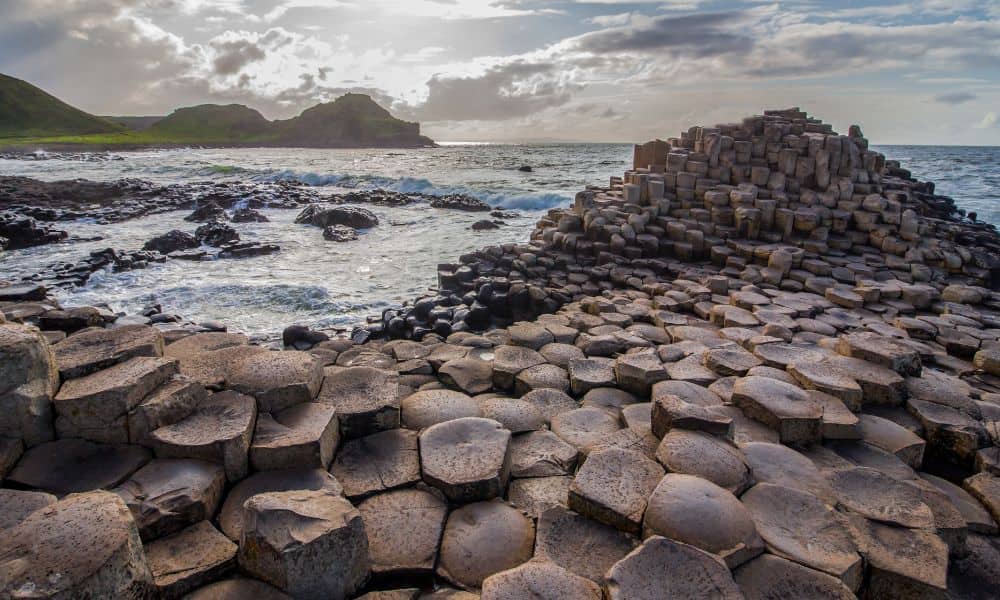
What is the Giant’s Causeway?
The Giant’s Causeway is a UNESCO World Heritage site known for its unique geological formations and affluent folklore. It is widely considered to be Europe’s most interesting natural wonder.
The pillar-like structures were formed several million years ago when molten basalt seeped through the chalk beds to make a large lava shelf. When it cooled, it left the structures you see today. The column size was determined by how long the lava took to cool.
The main attractions at the Causeway are the Hexagonal Columns, the Giant’s Boot, the Organ and the Wishing Chair.
legend of Finn McCool and the Giant’s Causeway
The legend of Finn McCool is an alternative to the geological explanation of how the causeway was formed. Finn, an Irish giant, created the stone path to cross the Irish Sea to fight his rival, the Scottish Giant Benandonner. Benandonner was so scared he is said to have ripped up the causeway as he fled back to Scotland, leaving behind what you see today.
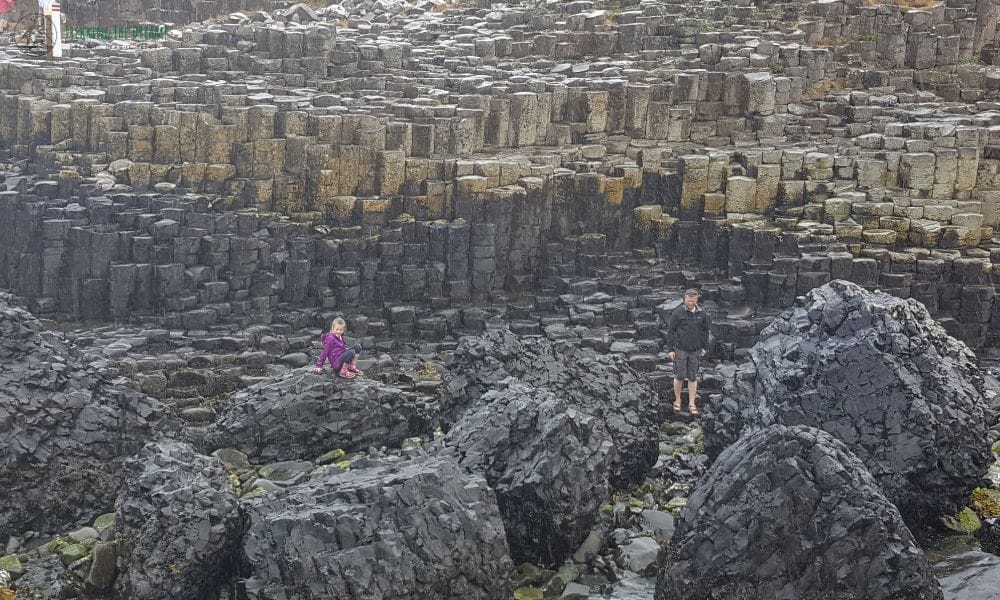
Facts About The Giant’s Causeway
- The Giant’s Causeway was formed over 60 million years ago by volcanic activity.
- More than 40,000 black basalt columns jut vertically out of the sea, with the tallest standing 12m high.
- The Irish often call the Giant’s Causeway their 8th Wonder of the World.
- Most columns are unique hexagonal, although some have four, five, seven and even eight sides.
- Whilst it looks man-made, it is entirely natural!
- The Giant’s Causeway is one of the most recognised natural phenomena in the UK.
- There are many shipwrecks in the surrounding waters of the Causeway.
Where is The Giant’s Causeway?
The hexagonal basalt columns of the Giant’s Causeway cover 4 miles (6km) of the northern coast of Northern Ireland in the United Kingdom.
Located in County Antrim, the rock formation is an hour from Londonderry or 90 minutes from Belfast.
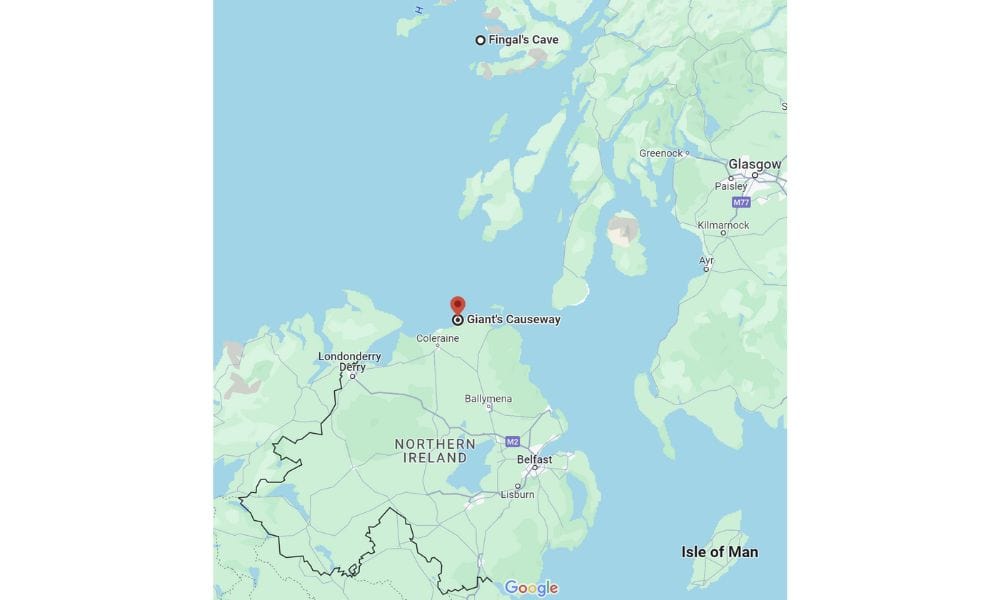
How to Get To The Giant’s Causeway
Travelling with kids requires some planning, so pack snacks, comfortable clothing and suitable footwear for climbing on wet stones. The drive to the Gaint’s Causeway is filled with scenic views, so keep your camera ready and be prepared to stop.
Driving by Car to the Giant’s Causeway
If you want a nice ocean view, follow the Causeway Coastal route from Belfast. The route is longer (minimum 2.5 hours), but the views are stunning.
Driving straight from Belfast to the Giant’s Causeway is around 1.5 hours.
Plan your route carefully to include stops along the way. Overtaking is almost impossible on this route, as it is very windy. So, if you have an unlucky day and get stuck behind a slow driver, you might spend 3 to 4 hours to reach the Causeway from Belfast.
Parking For The Giant’s Causeway
Parking at the visitor centre is well worth it if you have limited mobility, young children, or are short on time, as it is the closest parking to the Causeway. The car park can fill up during peak times, and there is a parking charge.
If you are not mobility impaired, our top tip is to use the park and ride from Bushmills or walk from your accommodation if you have older children.
Bus tours to the Giant’s Causeway from Belfast & Dublin
A guided bus tour from Belfast or Dublin is a fantastic option to see the Giant’s Causeway and other sights of interest. It is a long day for families, but many visits are included to get them off the bus.
Travel time is around 1hr 30min from Belfast and 3hrs from Dublin, but the trip will be 9-12 hours to include many other stops, making it worthwhile.
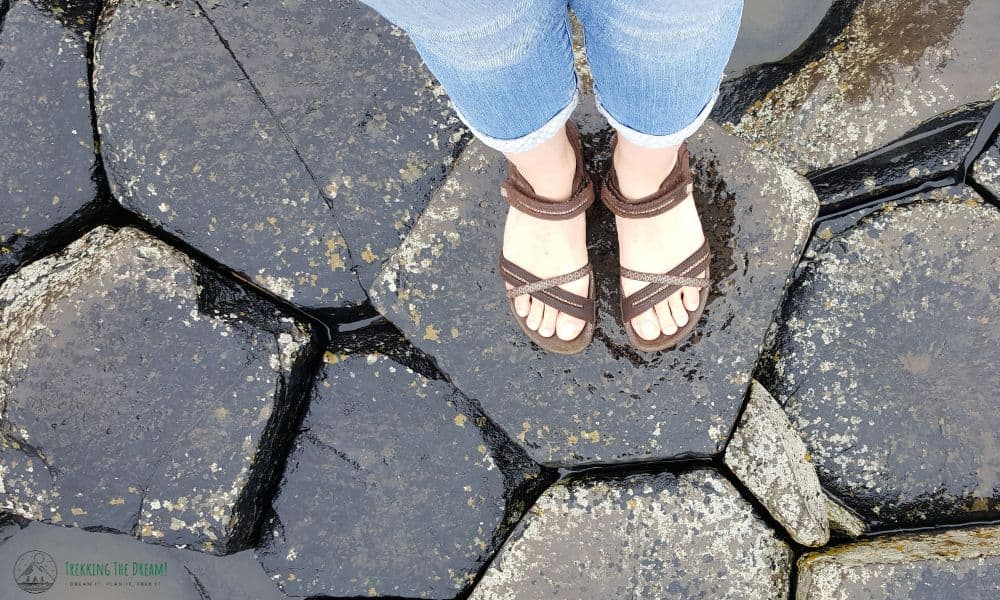
Best Time To Visit The Giant’s Causeway
The Giant’s Causeway is accessible all year. However, as you will be exposed to the elements in Ireland, you should check the weather forecast before visiting, especially with young kids. Our visit was shorter than intended as it poured with rain, although we did return in the evening once it was drier.
The best time to visit the Giant’s Causeway with kids is midweek when crowds are fewer.
Peak hours (1100-1500) are when the Causeway is busiest with tour groups. On a fine day, catching a stunning sunset over the rocks is worthseeing.
Giant’s Causeway Visitor Centre Opening Hours
The Causeway itself is open 24/7 all year round, but the National Trust Visitor Centre hours are:
March, April, May & October: 0900 – 1800
June, July, August, September: 0900 – 1900
November to February: 0900 – 1700
24th, 25th, 26th December: Closed
Giant’s Causeway weather
There is no shelter from the weather at the Giant’s Causeway. If you visit when it is raining or windy, you will need waterproof clothing and an umbrella. We got caught in the rain when we visited and got very wet very quickly, but luckily, the sun followed, and we dried off before we left.
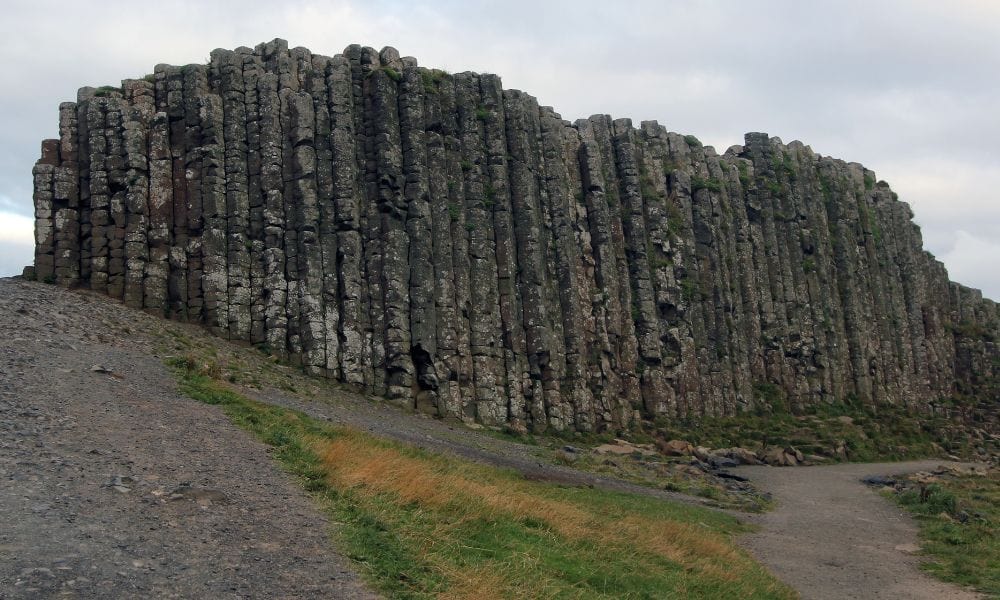
Giant’s Causeway walking routes
There are four popular trails to explore around the Giant’s Causeway:
Blue Trail. The Blue Trail is a wide, asphalt road leading to the causeway. It is less than a mile to walk downhill from the main car park and will take around 15 minutes each way.
Green Trail. This accessible clifftop path offers stunning views of the Causeway. On a clear day, you might be able to see across the Irish Sea to Scotland! Look for the many species of birds that call the cliffs home.
Red Trail. The Red Trail offers a fantastic panoramic view along the upper cliffs that hug the coastline. This walk takes around 40 minutes each way.
Yellow Trail. This is the longest of the three hiking trails. It follows the Causeway coastline from Runkerry House to Hamilton’s Seat and takes around an hour each way.
It is worth noting that the Green and Blue Trails are the only accessible options.
Eating at the Giant’s Causeway
We packed a picnic to recharge our energy while overlooking the sea.
The kids loved the sound of waves crashing against the rocks. Alternatively, there is a cafe in the National Trust Visitor Centre, Causeway Hotel or The Nook near the Causeway car park.
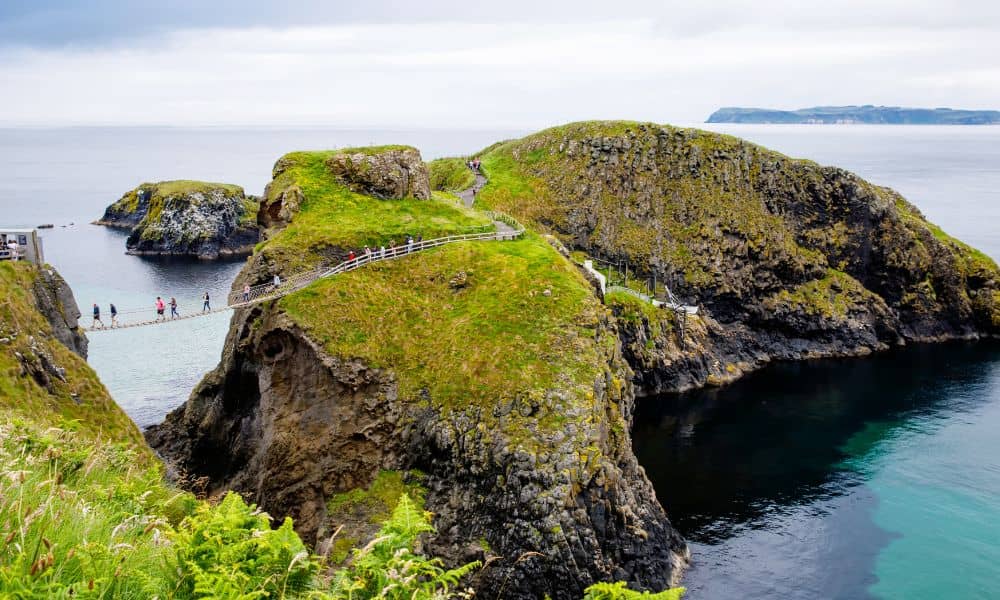
Things to do near the Giant’s Causeway
There are many options for family activities near the Giant’s Causeway, some of which are included on a bus tour. Our kids enjoyed visiting the beach and spending lots of time in the sea. Please note you can not swim at the Giant’s Causeway.
If you visit outside of the summer, the water may not be the ideal temperature for a dip, but don’t worry—there are plenty of other things to do!
Beaches Near The Giant’s Causeway
Portrush Beach, Whitepark Bay Beach and Portstewart Beach are all worth considering for beach activities. For a more sheltered spot for rockpools and a paddle, head to Dunseverick Harbour.
Visit Medieval Castles Near The Giant’s Causeway
Dunluch Castle (10 minutes), Dunseverick Castle (5 minutes) and Kinbane (20 minutes) are all worth visiting before or after seeing the Giant’s Causeway.
Carrick-a-Rede Rope Bridge
Not for the faint-hearted, this bridge links the mainland to the tiny island of Carrickared and stands 30m above the rocks below! First erected in the 1750s, it has been reconstructed over the centuries.
Game of Thrones Locations
There are dozens of filming locations around County Antrim, including The Dark Hedges’ Portstewart Strand, Larrybane Quarry and the Cushendun Caves – all made famous in ‘Game of Thrones’.
➡️Book this epic Giant’s Causeway and Game of Thrones Day tour that includes many of these must-see places
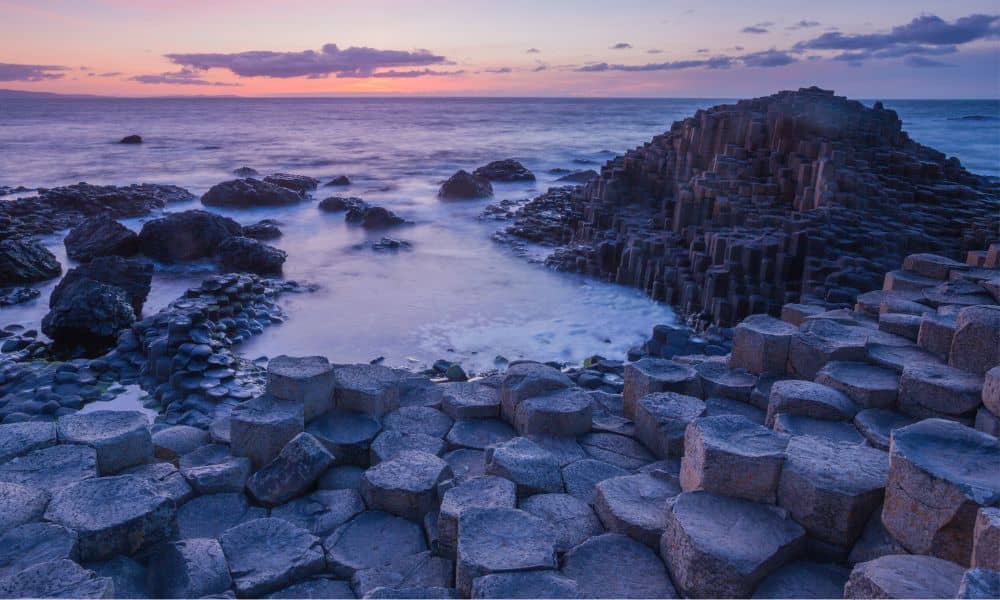
FAQ: Is visiting the Giant’s Causeway worth it?
This geological marvel is not for everyone; here are some common questions about the Giant’s Causeway.
Is the Giant’s Causeway Suitable For Kids?
The Giant’s Causeway in Northern Ireland is a perfect family day out for active, curious kids. They will gain insight into the natural hexagonal geological formations and spark their imagination with the folklore of the giants Finn McCool and Benandonner.
Can you take a Giant’s Causeway tour?
Guided tours are available and are run from the Visitor Centre. You can also take an audioguide that will give you the full geological explanation of how the Causeway was formed and, of course, the legend of Finn McCool.
Is Fingal’s Cave connected to the Giant’s Causeway?
The Giant’s Causeway, Ireland, can be traced geologically beneath the sea to Fingal’s Cave in Scotland.
Can You Visit The Giant’s Causeway for Free?
Yes, access to the Giant’s Causeway stones is free! There is, however, a charge to access the Causeway from the visitor centre and to use their car park, which is their fully accessible option. Limited free parking is available away from the site.
How long does it take to see the Giant’s Causeway?
Two hours will give you plenty of time to explore the Giant’s Causeway itself, although you may want to spend less or more time depending on the weather! The visitor centre has an excellent range of informative exhibits and should take you no more than an hour or so to get around.
Can You Swim At The Giant’s Causeway?
No, swimming in the sea is not permitted around the Giant’s Causeway due to the potential dangers of the ferocious sea and the rocks.
Final Thoughts: Is The Giant’s Causeway Worth Visiting With Kids?
A visit to the Giant’s Causeway when in Northern Island is essential. For kids, it is a place where nature wonder meets childhood imagination, creating an unforgettable experience for the whole family.
If you’re planning a trip with kids and will be in or near County Antrim, the Giant’s Causeway is a great destination.
